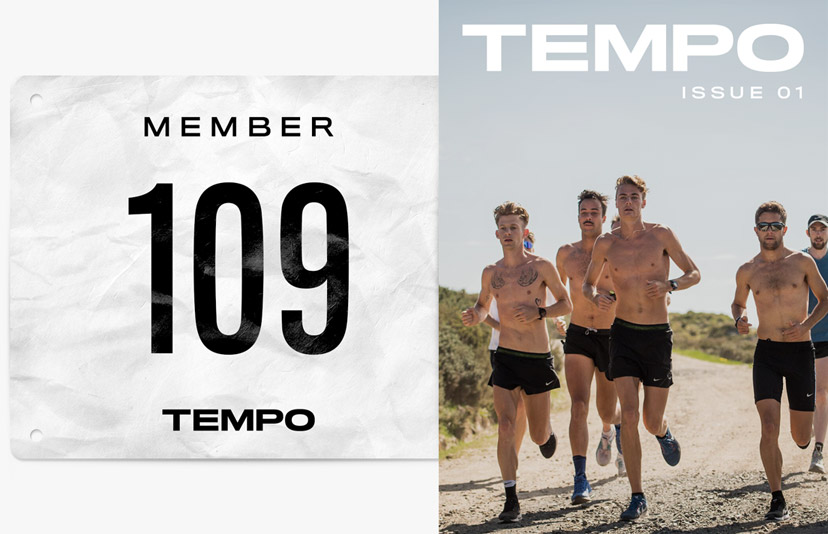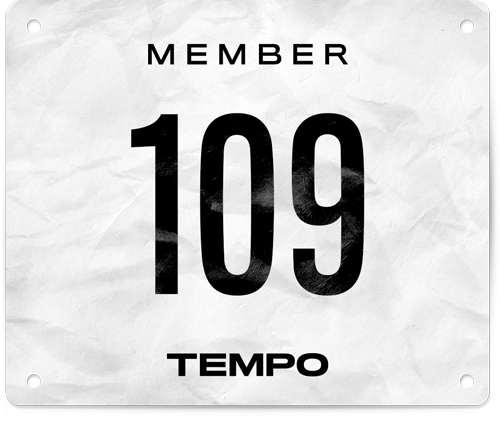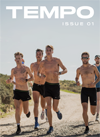Culture
Taking the Manhattan Bridge
Recapping the final Take The Bridge event of the summer
The intersection of Grand and Mulberry in Lower Manhattan brimmed with activity, even more than usual. Booths and pedestrians filled the pavement around a neon Ferris Wheel, carnival games, fried dough stations, Fasullo’s famous Italian sausage, and a concert stage. It was the San Gennaro festival, a ten-day celebration of Italian-American heritage that has been taking place in Manhattan’s Little Italy since 1926.
A block away, another crowd gathered around and within a glass storefront. The crowd was smaller, but just as boisterous—with energy palpably flooding the room. The store was Rowing Blazers, where Tracksmith’s New York City pop-up hosted the final Take The Bridge race of the summer.
The series began in 2015, when Darcy Budworth, then President of the New York Harriers, was tasked with throwing a race for that organization. As the name indicates, each race takes place across at least one bridge. Darcy drew inspiration from several New York City road racing staples—namely the Orchard Street Runners unsanctioned races, and the Red Hook Crit—and knew that the model of those races, ones that offered the community something more than the average road 5k, was what she wanted to emulate.
“I loved running over bridges, and so the idea was formed! Our first race was over the Queensboro Bridge, with 9 men and 11 women running one length of the bridge,” founder and race director Darcy recounted.
Take the Bridge has become more and more popular, with races selling out in less than five minutes this summer. The last race of the season, on September 14th, was no different—selling out around 40 slots in less than one minute.
Around 7:00 PM the night of the race, runners started arriving and making their way to the check-in table, tucked behind Tracksmith’s newly-unveiled Fall line.
“Bag check opens in 30 minutes,” someone yelled from the corner, and the room barely quieted to acknowledge this information. There were almost two hours before either of the races were scheduled to start.
Racing so late gives the bridges a chance to empty out. Often, the route required by the race calls for the runners to use what are usually designated bike lanes. But, the later it is, the fewer bikers there are to contend with during the race. Some of the races this summer started as late as 10:30pm.
Friday night’s race course was an out and back across the Manhattan Bridge, starting and finishing on the Manhattan side. Runners raced along the bike lane on the north side of the bridge, then ran to the Brooklyn waterfront before circling back to the start.
At 8:30pm, the runners gathered outside of Rowing Blazers for a shakeout to the start-line. Vans with everyone’s bags in them headed to the after party location and the mass of bodies rolled south, toward the mouth of the bridge.
The Manhattan Bridge sits in the heart of Chinatown on the Manhattan side, and opens up to traffic with an elaborate, grand arch and colonnade entry that seems slightly out of place surrounded by the neighborhood’s pagoda-inspired architecture.
"Take the Bridge has become more and more popular, with races selling out in less than five minutes this summer.
The last race of the season, on September 14th, was no different—selling out around 40 slots in less than one minute."
Jeanne Mack
After about a mile, the runners collected at a plaza by the bridge’s entrance, which quickly accumulated spectators. Some of the people gathering were not runners, just curious passersby drawn to the hubbub. These people were in street clothes, but that didn’t stop them from earnestly trying their hands at imitating the drills and stretches the runners performed in spurts of nervous energy.
Photographers, bikers, timers, and volunteers assembled at the start line. One runner asked the person beside them, “have you heard about the dirt path? Are you going to take it?” And together they weighed the pros and cons of the shortcut that exists on the other side of the bridge—one of the quirks that comes with unsanctioned racing.
The men’s race was first and they lined up five rows deep at the start of the bike lane, waiting for a break in bike traffic. Racers fidgeted with their glow-in-the-dark bracelets and neon hats and then suddenly, the timer screamed, “Ready, set, GO!” and they were off.
Darcy led them out on her bike, guiding them toward the checkpoint, and back. The first person who makes it to the checkpoint is awarded the prime of $50 cash—an incentive to make sure people are racing hard from the start.
Louis Serafini, from Boston, Massachusetts, probably didn’t need the extra incentive. In his first Take The Bridge race, Lou took it from the gun, sprinting alongside Darcy’s bike. At one point, about 100 meters into the race, Louis remembered, “Darcy turned around and goes ‘Wow! Taking it out!’, almost as if to suggest ‘I hope you know what you're doing…’.”
Lou definitely knew what he was doing, as he made it to the checkpoint first, collected the prime, and then back to the finish a minute and 47 seconds ahead of second place. Like most of the racers, Lou took the dirt path on the Brooklyn side of the bridge, but, “came very close to falling at that point. From there I had a general understanding of how to get down to the water where the check point was.”
Lou’s slight uncertainty of the course was representative of many of the racers, who hadn’t had time to scout out the exact directions earlier that day. But, Lou described, that’s part of the allure. “I think one of the coolest things about the race was that there is a slight degree of uncertainty... I had the lead bike (ahead of me) but not the whole time. I knew I was going the right way but wasn't 100% sure.”
Will Appman, who came in second in 17:27 behind Louis made the trek over to the start line from New Jersey, as a member of the Hoboken Harriers squad, and settled into second place in the race on the way out across the bridge. Appman describes that “shadows from the overheard lights indicated that competition was close behind on the bridge.”
After getting held up by a couple of cars in Brooklyn on the way to the checkpoint, he closed the gap on the competition, but then fell back again on the uphill of his return on the Manhattan Bridge.
“A kick around 2.5 miles put me ahead for good. Having the marshalls lighting intersections on the streets was definitely helpful for the second half.”
Rounding out the men’s top five were Jeremy Arthur in third (17:34), Mike Darnell (17:36), and Derek Scott (17:38).
Minutes after the men’s race finished, the women lined up. In an almost Groundhog Day-like scene, they too were many rows deep as they stood by until there was a pause in bikers. It was a truly deep field, evidenced by a full pack of women charging across the Manhattan Bridge together, without one person breaking away. But after a few minutes, British Columbia-native Briana Hungerford took the lead.
As she did so, she thought, “this is either going to be the worst or most epic race. Coming off the bridge, I managed to spot the mini shortcut dirt path and then zipped through the streets unaware of traffic. I was too focused on getting to the checkpoint. I never looked at my watch to check my pace, I just ran. The bridge was loud and dark with trains passing by and I had no clue how close anyone was. If someone was right behind me, I had no idea. I looked back at one point but couldn’t see anything, I knew I just needed to keep moving and the home stretch was close.”
It was her first run in New York City, and despite not having much context for where exactly she was, Briana kept sprinting toward the finish. She threw her arms up as she broke the tape in 18:53, edging out second place Corinne Fitzgerald by ten seconds (19:03).
Corinne, a local New York City runner and coach at Mile High Run Club, hung with Briana when she made her move into the lead, and while the race wasn’t Corinne’s fastest or best showing, she knows it was the, “fastest I’ve run in a long time.” Corinne credits the ambiance of the race as part of what pushed her to compete. “There’s a sort of ‘breaking the rules’ badass vibe to it that I think pushes you to run faster. You don’t know what pace you’re running, you don’t know where the mile markers are, you’re just running to beat the person in front of you and that’s awesome.”
The rest of the women rolled in steadily after the top two, with Nicole Falcaro (19:05), Emmi Aguilard (19:51), and Katie Michno (19:55) finishing up the top five.
Emmi has participated in a couple of Take The Bridge races, and her strategy is usually the same. “I like to get the prime and then die,” she explained between breaths after she finished. This time though, Briana got both the prime and the first-place prize. A few feet away, Corinne sat on the ground with her legs splayed out and said, “I think I need to either vomit or take a nap.”
"The bridge was loud and dark with trains passing by and I had no clue how close anyone was. If someone was right behind me, I had no idea."
Briana Hungerford
After the runners caught their breath and cooled down from the race, they headed to the after party, where their bags along with pizza, music, beer, wine, and rosé were waiting for them. Held at a WeWork event space in southern Manhattan, the party “embodied all that the running community is about,” Corinne Fitzgerald summarized. Whether they were locals, or not, the competitors gushed about the chance to spend time together while not actively trying to outrun each other.
William Appman thought, “it was great mingling with local runners who are so passionate and loyal to the sport of road racing. The entire TTB team put together a really nice event that was a great way to celebrate our accomplishments as a group.”
And it’s this sort of paradox that Take The Bridge has thrived on. The combination of celebrating an entire community of runners, while still encouraging fierce competition between individuals; giving runners the freedom to navigate the routes, but requiring certain checkpoints be hit; and asking runners to be self-reliant and cognizant of traffic, but also providing the structure of bikers and volunteers helping them to succeed. It’s the mingling of such opposites that allows this series to be something other than a regular road 5k.


